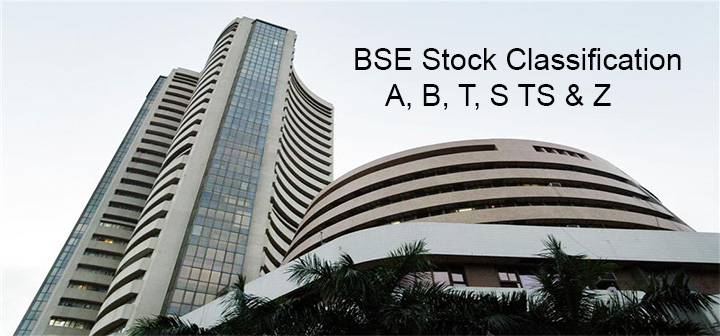Stock classification is the process of grouping stocks for ease of understanding. In India both BSE (Bombay Stock Exchange) and NSE (National Stock Exchange) classifies stocks. More or less the classification of stocks is similar on both platforms.
This stock classification was done to handle the stocks based on trading characteristics of Indian shares on the exchange platform and are known as grades. Mainly there are seven grades of stocks namely, A, B, T, S, TS & Z. All other stocks which fail the characteristics of any one of these grades were kept in others. These grades are scores of stocks on the basis of their size, liquidity and exchange compliance. Moreover, you will also reason yourself for any of your’s such decisions.
Characteristics of stock classification in India
In the following section, I will discuss the main characteristics of various stock classification in India. This will help you in understanding whether you should invest in any one of these categories and hold for how much time. Whether you need to hold an ‘A’ category in your long term portfolio or you need to avoid ‘Z’ category stocks, all you will understand properly.
A group stocks – highly liquid stocks
- The stocks fall in the category of A ‘Group’ are the most liquid counters among all the stocks listed on the BSE.
- The market rates group A stocks as excellent in all aspects and they also show comparatively high traded volume during trading.
- Settlement of group A stocks trades is done under the normal rolling settlement process.
T group stocks – the stocks in trade-to-trade
- The stocks fall under T group follows trade-to-trade settlement system of the exchange.
- Each trade in this group is seen as a separate transaction and there is no netting-out of trades as in the rolling system
- The traders who buy shares of this category or sell the script of this group, have to pay the amount or deliver the shares by T+2 days.
- For example, you bought 100 shares of T Group and sold another 100 shares on the same day. Then, the shares you have bought, you will have to pay the price of those shares in two days. And for the shares you have sold, you will have to make the delivery of shares by T+2 days, so that Exchange can make the settlement on time.
- Stocks of T group are regularly moved in and out of trade-to-trade settlement depending on the speculative interest that governs them.
S group stocks – small and medium stocks
- The stocks of ‘S Group’ fall under the BSE’s Indonext segment.
- The BSE Indonext comprises small and medium companies that have a listing in the regional Stock Exchange.
- Generally, the turnover of S grade companies is rupees 5 crore and tangible assets of rupees 3 crore.
- Apart from the small size of the company, the other risk that comes with investing in them is low liquidity.
TS group stocks – it is a mix of T & S groups
- TS group is the combination of T & S group of shares.
- It consists of stocks in the “BSE-Indonext” segments also.
- These category stocks settle on a trade-to-trade basis as a surveillance measure.
Z group stocks – caution to retail investors
- The companies of Z grade stocks have not complied with the exchange’s listing requirements that have failed to redress investor’s complaints.
- This grade also includes stocks of companies that have dematerialization arrangement with only one of the two depositories – CDSL and NSDL.
- The stocks of Z category are the riskiest scripts. Not much information is available to such companies in the public domain.
- These companies have low media coverage that keeps them relatively hidden from public scrutiny that makes such scripts more vulnerable to insider trading.
- Z Group companies already have a poor score in redressing investor complaints.
B group stocks – stocks that are left behind
- B Group comprises stocks that don’t fall in any of the other groups.
- These counters see normal volumes and settle under the rolling system.
Other classification
- Tradable financial instruments which are other than companies stocks, form “Others”. Group G & F falls under “others”.
- The exchange also facilitates trading in fixed income securities, like company deposits. These instruments form F Group.
- Retail investors trade in government securities like long-dated GOI bonds on the exchange. Instruments of government securities come in Group G.
Besides these groups, the exchange has also some other method of stock classification. One such stock classification refers to the SLB group. Further, based on the market capitalization of companies, the exchange had also classified the listed company’s stocks, viz. large, mid and small cap stocks.
The short form of market capitalization is ‘market cap’ or ‘m-cap’. It refers to the total monetary value of the outstanding shares of any company in the market at any point in time. The formula for calculating M-cap is multiplying the price of each share of a company by the total number of issued shares. Further discussions cover this.
SLB group stocks
- SLB stands for Securities Lending & Borrowing and is a scheme introduced by SEBI in 2007 for short sellers.
- This scheme facilitates the borrowing of securities by a short seller in the market and helps in the settlement process.
- In short selling, you can sell stocks without actually holding them.
- A total of 207 companies is there in SLB group. Both the retailer and institutional investor participates in short sell and SLB scheme.
- It is advisable that whenever you choose stocks to invest, be aware of the category in which the stock falls.
“What you are waiting for? Join RMoney India for if investing in the stock market appeals you.”
Groups based on market capitalization
- Large-cap stocks – The market capitalization value of large-cap company’s share is more than 10 billion rupees.
- Mid-cap stocks – The second group is the stocks of companies with a market capitalization in between two and ten billion rupees comes under the mid-cap.
- Small cap stocks – The last group in this segment is that of small cap. These are stocks of companies whose market capitalization lies in between rupees 300 million and rupees 2 billion.
It is important to note that both BSE and NSE have their own way to group listed stocks. These classifications serve a particular purpose to both the exchange and the investors. The NSE classification gives you a sense of volume for the stocks. On the other hand, the BSE stocks classification helps you in two ways. It not only helps in determining liquidity but also segregates on the detailed quality of the stocks. However, the grouping of stocks on the basis of market capitalization is a sort of universal method of classifying stocks.
About Author

Stock Trading Now trade in ₹9 Per Order or ₹ 999 Per Month Plans.
Future & Options Access F&O contracts with advanced tools for hedging and speculation.
Currency Trading Trade in major currency pairs and manage forex exposure efficiently.
Commodity Trading Diversify Trading with MCX & NCDEX by Trading in Gold, Silver, Base Metals, Energy, and Agri Products.
Margin Trading Funding Boost your buying power with upto 5X, Buy now Pay Later
Algo Trading Back test, Paper Trade your logic & Automate your strategies with low-latency APIs.
Trading View Leverage Trading View charts and indicators integrated into your trading platform.
Advanced Options Trading Execute multi-leg option strategies with precision and insights.
Stock Lending & Borrowing Earn passive income by lending stocks securely through SLB.
Foreign Portfolio Investment Enable NRIs and FPIs to invest in Indian markets with ease and compliance.
IPO Invest in upcoming IPOs online with real-time tracking and instant allotment updates.
Direct Mutual Funds 0% Commissions by investing in more than +3500 Direct Mutual Fund Scheme.
Corporate FDRs Earn fixed returns with low-risk investments in high-rated corporate fixed deposits.
Stocks SIPs Build long-term wealth with systematic investment plans in top-performing stocks.
Bonds & NCDs Access secure, fixed-income investments through government and corporate bond offerings.
Depository Services Safely hold and manage your securities with seamless Demat and DP services with CDSL.
Insurance One-Stop Destination For All Your Insurance Needs. Compare Quotes from Top Insurers & save bigs.
Journey Tracing our growth and milestones over time.
Mission & Vision Guided by purpose, driven by long-term vision.
Why RMoney Platform Smart, reliable platform for all investors' needs.
Management Experienced leadership driving strategic financial excellence.
Credentials Certified expertise with trusted industry recognition.
Press Release Latest company news, updates, and announcements.
Testimonials Real client stories sharing their success journeys.
7 Reasons to Invest Top benefits that make investing with us smart.
SEBI Registered Research Trusted insights backed by SEBI-compliant research.
Our Technology Advanced tools enabling efficient online trading.
Calculators Access a suite of smart tools to plan trades, margins, and returns effectively.
Margin Calculator Instantly check margin requirements for intraday and delivery trades.
MTF Calculator Calculate MTF funding cost upfront to ensure full transparency before placing a trade.
Brokerage Calculator Know your exact brokerage charges before placing any trade.
Market Place Explore curated investment products and trading tools in one convenient hub.
RMoney Gyan Enhance your market knowledge with expert blogs, videos, and tutorials.
Performance Tracker Track our research performance with full transparency using our performance tracker.
Feedback Share your suggestions or concerns to help us improve your experience.
Downloads Access important forms, software, and documents in one place.
Locate Us Find the nearest RMoney branch or service center quickly.
Escalation Matrix Resolve issues faster with our structured support escalation process.
Back Office Log in to view trade reports, ledger, and portfolio statements anytime.
Account Modification Update personal or bank details linked to your trading account.
Fund Transfer Transfer funds instantly online with quick limit updation to your trading account.
Bank Details View our registered bank account details for seamless transactions by NEFT, RTGS or IMPS.
How to Apply IPO Step-by-step guide to apply for IPOs using your trading account.
RMoney Quick Mobile App Trade on-the-go with our all-in-one mobile trading app.
RMoney Quick login Quickly access your trading account through the RMoney Quick web-based trading.
RMoney Rocket Web Version Experience powerful web-based trading with advanced tools for algo traders.
RMoney Rocket Mobile Version Trade anytime, anywhere with our feature-rich mobile trading platform.




















